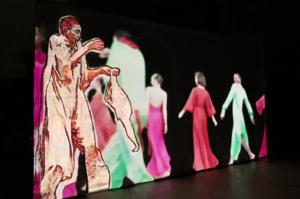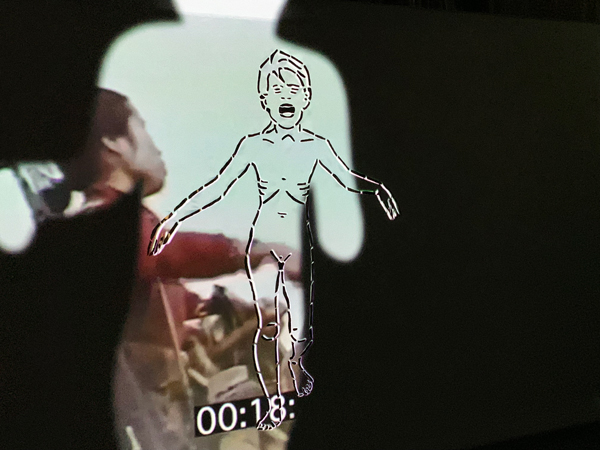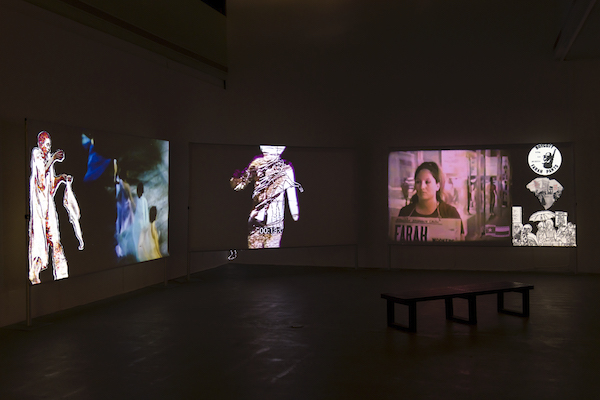On the weekend before everything locked down in Los Angeles, I was fortunate enough to catch the exhibition “To View a Plastic Flower” at the Los Angeles Municipal Art Gallery and to hear one of the featured artists, Vietnamese American artist T. Kim-Trang Tran, discuss her three-channel video installation, Movements: Battles and Solidarity. The installation coalesces three seemingly disparate events during the early 1970s in high fashion, labor unrest and the Vietnam War by exploring the shared sociopolitical and physical “movements.”
Tran received her MFA from the CalArts and a BFA from the University of Iowa and is currently a professor of art at Scripps College in Claremont, CA. She lives and works in Los Angeles and her work has been exhibited and screened nationally and internationally, including at the Hammer Museum and the Whitney Museum of American Art’s Biennial in 2000.
Although the LAMAG exhibition officially closes on April 19—unlikely that we will be able to see her work there now—Tran’s installation is currently also scheduled to be on view at USC Pacific Asia Museum in Pasadena from July 1 to August 1, so we will all hopefully have a second chance to see it
I recently reached out to her to ask her a few questions about the work.
MM: Your work “Battles and Solidarity” focuses on political and social movements that occurred in and around 1973. Why did you choose that year?
TKT: The project covers the years 1972–74 and started with my focus on the 1973 fashion show that came to be known as The Battle of Versailles, as discussed in Robin Givhan’s book of the same name. What drew me to this moment in fashion was its mix of race and class issues. Organized as a fundraiser to restore the Palace of Versailles, the show paired five American fashion designers with five French luminaries. By all accounts, the Americans won with their brief show’s disco-infused energy, race-conscious models, and ready-to-wear lines, and it forever changed American fashion.
From there, I looked at the wider context, beyond what the book covered, and the event and image of the iconic “Napalm Girl” leapt out. From the height of being clothed to the depth beyond nakedness: flayed by napalm, this event was just a year prior, on the other side of the world from Versailles. The Vietnam War, seen by some as imperialist, also made me think about how the Brits cornered the global cotton trade in the 19th century through waging war, as discussed in Sven Beckert’s book, The Empire of Cotton. Though not a direct goal, I wondered if the American War in Vietnam can be seen as a modern instance of war capitalism, benefiting American fast fashion.
Then I thought about what enabled American fashion and began to focus on the labor struggles of garment workers, who were and still are predominantly women. The long ’70s is a personal, artistic and academic preoccupation for me. My family left Vietnam amidst the war in 1975, and the class, race, gender and cultural politics of that era still impact so much of what we’re all living through today.

T. Kim-Trang Tran, close up of “Movements: Battles and Solidarity.”
Women and clothing seem to link the three sections of the video installation – women in high fashion in France, female textile industry workers in the U.S. and the unclothed “Napalm Girl” in Vietnam. Can you explain the importance of this theme and how you have connected the three images?
I’ve long held an interest in high fashion that’s only recently converged with my ongoing study of gender and labor and a newer practice of building hand-made fabric screens for video projection. The screen treatments for Battles and Solidarity add another layer to both its form and content.
The left screen in the triptych, titled Runway Revolution, features a life-size, hand-embroidered image of the model Billy Blair, considered the star of the Versailles fashion show, as she conjures a scene of diverse models, who were voguing before its time. As a historically high-end decorative art, hand embroidery fits with the opulent Versailles show. This screen was hand-embroidered by three women in Vietnam in about six weeks; their skill and scale unmatched by peers in Los Angeles.
The center screen, titled War Capitalism, features a line drawing of Kim-Phuc Phan, a.k.a. the Napalm Girl, that is cut into the screen fabric with a hot knife to reference napalm’s burning of the children’s skin. In contrast to the Napalm Girl image, I highlight other women’s experiences in the war through the six-channel audio tracks and moving image.
The title of the right screen, Labor Once Cheaper Than Cotton, references the slave labor that enabled the cotton trade in America. The screen is printed with graphics from three wildcat strikes by predominantly women garment workers: one in El Paso, Texas at the Farah Manufacturing Inc. by mostly Chicana workers; the second at the Oneita Knitting Mill in Andrews, South Carolina by mostly African-American women; and the third by Chinese-American women at the Jung-Sai company, a subsidiary of Esprit de Corp. They all won their strikes for the right to be represented by a union.

T. Kim-Trang Tran, closeup of “Movements: Battles and Solidarity.”
The videos are projected on three large screens. There are also fixed elements on each screen that relate to the theme of the work. Is there a deliberate juxtaposition of movement and the static at work?
I see two ways, and there could be more, to consider the conversations happening within each screen between the moving and fixed elements as well as across the three screens. On one level, the static elements pin world history onto a particular screen while the moving images are in conversation with cinematic history through Muybridge’s motion study. The three video channels explore the shared political and physical “movements” made manifest in the models’ catwalk, the girl’s run, and the striking workers’ march.
On another level, the moving images celebrate the collective empowerment of diverse women in these specific years while the static elements mark the slow to change or unchanging nature of race, class, and gender struggles. An example of this would be that, while race and class seemed triumphant in the Americans’ win at Versailles, the models who helped to promote quicker fashion and ensured Haute couture’s financial survival were themselves underpaid; while they were celebrated, they were not integrated into the world of high fashion. Yet what’s common across the screens are the victories of these women in this time.



















0 Comments